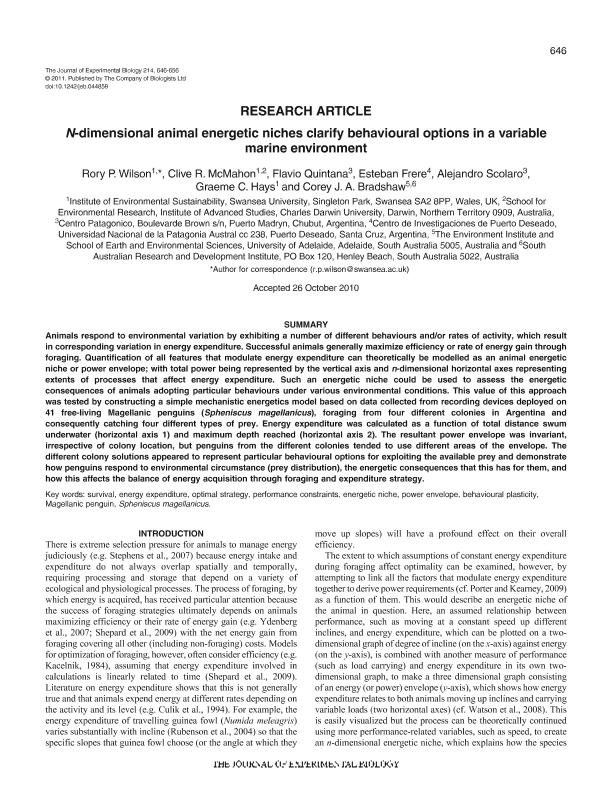Mostrar el registro sencillo del ítem
dc.contributor.author
Wilson, Rory P.

dc.contributor.author
McMahon, Clive R.
dc.contributor.author
Quintana, Flavio Roberto

dc.contributor.author
Frere, Esteban

dc.contributor.author
Scolaro, Jose Alejandro

dc.contributor.author
Hays, Graeme C.
dc.contributor.author
Bradshaw, Corey J. A.
dc.date.available
2019-09-27T21:07:01Z
dc.date.issued
2011-02
dc.identifier.citation
Wilson, Rory P.; McMahon, Clive R.; Quintana, Flavio Roberto; Frere, Esteban; Scolaro, Jose Alejandro; et al.; N-dimensional animal energetic niches clarify behavioural options in a variable marine environment; Company of Biologists; Journal of Experimental Biology; 214; 4; 2-2011; 646-656
dc.identifier.issn
0022-0949
dc.identifier.uri
http://hdl.handle.net/11336/84734
dc.description.abstract
Animals respond to environmental variation by exhibiting a number of different behaviours and/or rates of activity, which result in corresponding variation in energy expenditure. Successful animals generally maximize efficiency or rate of energy gain through foraging. Quantification of all features that modulate energy expenditure can theoretically be modelled as an animal energetic niche or power envelope; with total power being represented by the vertical axis and n-dimensional horizontal axes representing extents of processes that affect energy expenditure. Such an energetic niche could be used to assess the energetic consequences of animals adopting particular behaviours under various environmental conditions. This value of this approach was tested by constructing a simple mechanistic energetics model based on data collected from recording devices deployed on 41 free-living Magellanic penguins (Spheniscus magellanicus), foraging from four different colonies in Argentina and consequently catching four different types of prey. Energy expenditure was calculated as a function of total distance swum underwater (horizontal axis 1) and maximum depth reached (horizontal axis 2). The resultant power envelope was invariant, irrespective of colony location, but penguins from the different colonies tended to use different areas of the envelope. The different colony solutions appeared to represent particular behavioural options for exploiting the available prey and demonstrate how penguins respond to environmental circumstance (prey distribution), the energetic consequences that this has for them, and how this affects the balance of energy acquisition through foraging and expenditure strategy.
dc.format
application/pdf
dc.language.iso
eng
dc.publisher
Company of Biologists

dc.rights
info:eu-repo/semantics/openAccess
dc.rights.uri
https://creativecommons.org/licenses/by-nc-sa/2.5/ar/
dc.subject
BEHAVIOURAL PLASTICITY
dc.subject
ENERGETIC NICHE
dc.subject
ENERGY EXPENDITURE
dc.subject
MAGELLANIC PENGUIN
dc.subject
OPTIMAL STRATEGY
dc.subject
PERFORMANCE CONSTRAINTS
dc.subject
POWER ENVELOPE
dc.subject
SPHENISCUS MAGELLANICUS
dc.subject
SURVIVAL
dc.subject.classification
Biología Marina, Limnología

dc.subject.classification
Ciencias Biológicas

dc.subject.classification
CIENCIAS NATURALES Y EXACTAS

dc.title
N-dimensional animal energetic niches clarify behavioural options in a variable marine environment
dc.type
info:eu-repo/semantics/article
dc.type
info:ar-repo/semantics/artículo
dc.type
info:eu-repo/semantics/publishedVersion
dc.date.updated
2019-09-20T15:11:03Z
dc.journal.volume
214
dc.journal.number
4
dc.journal.pagination
646-656
dc.journal.pais
Reino Unido

dc.journal.ciudad
Cambridge
dc.description.fil
Fil: Wilson, Rory P.. Swansea University; Reino Unido
dc.description.fil
Fil: McMahon, Clive R.. Swansea University; Reino Unido. Charles Darwin University. School of Environmental Research; Australia
dc.description.fil
Fil: Quintana, Flavio Roberto. Consejo Nacional de Investigaciones Científicas y Técnicas. Centro Científico Tecnológico Conicet - Centro Nacional Patagónico; Argentina
dc.description.fil
Fil: Frere, Esteban. Consejo Nacional de Investigaciones Científicas y Técnicas. Centro Científico Tecnológico Conicet - Centro Nacional Patagónico; Argentina. Universidad Nacional de la Patagonia Austral. Unidad Académica Caleta Olivia. Centro de Investigaciones Puerto Deseado; Argentina
dc.description.fil
Fil: Scolaro, Jose Alejandro. Consejo Nacional de Investigaciones Científicas y Técnicas. Centro Científico Tecnológico Conicet - Centro Nacional Patagónico; Argentina
dc.description.fil
Fil: Hays, Graeme C.. Swansea University; Reino Unido
dc.description.fil
Fil: Bradshaw, Corey J. A.. University of Adelaide; Australia. South Australian Research and Development Institute; Australia
dc.journal.title
Journal of Experimental Biology

dc.relation.alternativeid
info:eu-repo/semantics/altIdentifier/url/https://jeb.biologists.org/content/214/4/646
dc.relation.alternativeid
info:eu-repo/semantics/altIdentifier/doi/http://dx.doi.org/10.1242/jeb.044859
dc.relation.alternativeid
info:eu-repo/semantics/altIdentifier/url/https://www.semanticscholar.org/paper/N-dimensional-animal-energetic-niches-clarify-in-a-Wilson-McMahon/fc2e2d57f29b896d9951fe431f9deb1c33b4d30d
Archivos asociados
